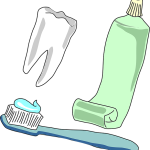Yesterday I posted an update on fluoride via Facebook and received some questions from some concerned mamma’s, so I thought I would provide some additional information, as well as the best way to prevent cavities without the use of fluoride. I apologize for the long post, but I had a lot to share!
The article I posted linked to a study published in The Lancet, which finally “officially” classified fluoride as a neurotoxin. Despite more than 300 studies that have documented fluoride as a neurotoxin, our water supply is still pumped with fluoride and dentists are still prescribing fluoride supplements to children they consider “at risk”. Yikes! Unfortunately, there is simply not statistically significant data to support that fluoridated water reduces dental carries. You can read more here.

In addition to being a neurotoxin, here are other health related effects of fluoride:
• Endocrine disruptor
• Arthritis
• Bone fractures
• Osteosarcoma (Bone cancer)
• Diabetes
• Male Infertility
• Thyroid function
So, now that we have determined that fluoride is harmful (especially for children), here are some ways to prevent cavities naturally.
Ways to Prevent Cavities Naturally
DIET/NUTRITION
Dr. Weston Price was a dentist who studied indigenous cultures and found them to be free of cavities until they introduced westernized refined foods into their diet. Not surprisingly, one of biggest contributors to tooth decay is a poor diet. Here are the top 3 when it comes to diet:
1. Too much refined sugar/processed foods
2. Lack of minerals – caused by high phytic acid foods and/or inadequate diet
3. Lack of fat-soluble vitamins – A, D, K, and E
Avoid/Limit
Added sugars – Sugar feeds oral bacteria and is also highly acidic causing demineralization of the tooth structure. Refined sugars should be avoided and natural sweeteners such as raw honey and maple syrup should be limited.
Phytic acid – Phytic acid (phytate) is an anti-nutrient that is found in nuts, seeds, legumes, and whole grains. It blocks mineral absorption of zinc, iron, magnesium, phosphorus, and calcium. An easy way to reduce the phytic acid content in these foods is to either soak, sprout, or ferment them before eating them.
Processed foods/packaged foods/fast food – this should be self-explanatory.
Include – foods that prevent cavities
Vegetables – Include plenty of raw and cooked vegetables in your diet daily, especially lots of leafy greens.
Raw dairy products – If you (or your kiddo) are tolerant of dairy, raw fermented foods such as kefir, cheese, and grass-fed butter are great sources of the fat-soluble vitamins A, D, and K, as well as calcium, magnesium, and phosphorus, which are all essential for bone health.
High quality fats – Coconut, avocado, olives, cold-water fish (or cod liver oil).
Bone broth – Regular consumption of bone broth provides a great source of minerals for teeth. Make sure you use organic/pasture-raised/grass-fed bones.
Vitamin D – Get plenty of sunshine and supplement with vitamin D in the winter months.
PROBIOTICS
Let’s not forget that the oral cavity is part of our GI tract microflora and it’s just as important to keep a healthy balance of predominantly good bacteria there as well. Bacteriotherapy through the use of probiotics is an emerging field of study in the dentistry field and we are already beginning to see promising results.
Studies have identified probiotics strains that have shown beneficial effects on reducing dental carries in children. [1] The following products are available on the market now that contain these specific strains:
- Culturelle Probiotics
- Standard Process Prosynbiotic
- BioGaia ProTectis and BioGaia Probiotic Straw
ALTERNATIVES TO FLUORIDE TREATMENT
If you are interested in alternatives to fluoride there are some holistic treatments that support good oral health.
Neem – Studies have found neem to be effective at significantly reducing gingivitis, gum bleeding, and plaque buildup. [2,3] You can look for fluoride free neem toothpaste and/or use neem mouthwash.
Oil Pulling – One way to reduce pathogenic bacteria in the mouth is through an ancient Ayurvedic technique called oil pulling. Sesame is the oil that has been traditionally used and studied and has been shown to specifically inhibit the growth of decay-causing microbes. You can read more about it here. Coconut oil has gained popularity as the oil of choice, although there has been only one recent study showing its effectiveness for reducing plaque formation and gingivitis. [4]
Additional Resources
I also highly recommend the book Cure Tooth Decay by Ramiel Nagel if you are interested in reading more about how to heal cavities and prevent tooth decay with nutrition.
Also, www.fluoridealert.org is a great resource if you want to read more about studies on fluoride and human health. They also have a great FAQ section.
Resources
1. Anusha, Rangare Lakshman et al. The Magic of Magic Bugs in Oral Cavity: Probiotics. Journal of Advanced Pharmaceutical Technology & Research 6.2 (2015): 43–47.
2. Chatterjee, A. et al. To evaluate the antigingivitis and antiplaque effect of an Azadirachta indica (neem) mouthrinse on plaque induced gingivitis: A double-blind, randomized, controlled trial. Journal of Indian Society of Periodontology. 15 (4).
3. Botelho, M. A. et al. Efficacy of a mouthrinse based on leaves of the neem tree (Azadirachta indica) in the treatment of patients with chronic gingivitis: A double-blind, randomized, controlled trial. Journal of Medicinal Plants Research. 2 (11).
4. Peedikayil, F.C. et al. Effect of Coconut Oil in Plaque Related Gingivitis — A Preliminary Report. Nigerian Medical Journal : Journal of the Nigeria Medical Association 56.2 (2015): 143–147.

